Larry D. Marshall's Blog
September 10, 2023
I Forgot I Had A Blog
Like for many, this summer has been wild with respect to weather. All the places on the planet who are dealing with drought need to know, all your water is over here, and falling regularly. And while that has upset a lot of our summer plans, it hasn’t been the main thing that’s kept me from sketching and posting here.
The real reason was a “little” project we needed to do. The stairs to the back of our house (onto our deck) needed to be replaced. And so it was with carefree attitudes and a good dose of “how hard can it be” that we ripped out the old with the intent of building a new set. Easy peasy. That’s when our old house became a rerun of that old movie, The Money Pit (grin).
Once removed we could see under our deck and we could see the wall on the other side of it. We could see the supports for the deck. And we could see that both were falling apart from water damage and rot. We were/are suddenly up to our armpits with big jobs that retired research scientists aren’t trained to do. Much reading and many YouTube videos later and I started to understand some of the particulars.
I won’t bother you with the details. Suffice it to say that we’ve spent July and August working hard to keep our house from falling down. I also built a new set of doors for the storage area under our deck. Finally I got to think about building stairs. MyCarpentry.com has been a big help.
The stairs are built and with any luck, we’ll have themthose stairs and an associated wall in place within a week. Anyway, while I’ve sloshed a couple gallons of paint, none of it has been as a sketcher. I do sit and doodle sometimes, though. I spread out some of the pieces of paper strewn around my drawing table for your perusal. Wish there was more. If I can get the stairs installed I’m scheduled to attend art workshops in Montreal with Marc Taro Holmes and Shari Blaukopf as instructors. Maybe they’ll remind me how to use fuzzy sticks to apply paint to paper. I hope so. Sorry the blog has gone dark for so long.
[image error]July 15, 2023
Master Studies For Sketchers
This summer has been crazy so far. Here we’ve had heat waves, followed by lots of rain, forest fire smoke and in recent days, tornado warnings. When do the grasshopper and frogs start falling from the sky?
I’ve continued my pursuit of watercolor knowledge and expertise. They say you learn from your mistakes so I must be learning a lot. I did learn something important.. really important. If you cut up a bunch of 100% cotton paper into small squares and leave them out in high humidity, they go bad.
Well, I did that. When I started my 30x30DirectWatercolor thing I cut up a bunch of Fabriano Artistico into 5×5 and 4×6 squares, about 50 of them and just piled them on my drawing table. Mother Nature provided the humidity. Its been a banner year for humidity in Quebec.
Anyways, I spent a month struggling to get watercolor to cooperate on those 5×5 squares and only recently found that at least some of my problems have come from the sizing going bad on those squares. I couldn’t figure out why the paint would immediately soak into the paper, always had fuzzy edges, etc. Oh well.
Recently I’ve continued to pursue watercolors, this time by doing a master study of a sketch I saw in an online presentation. I’d love to tell you who did the original but I can’t find the video. Most times when master studies are discussed people are trying to replicate Zorn, Sargent, or some other great artist. That’s fun but I get more information by trying to copy some particular aspect of a person’s work. In this instance I was trying to replicate the splotchy, rusty nature of this chimney. This is actually my second attempt at it but I was pleased with the result.
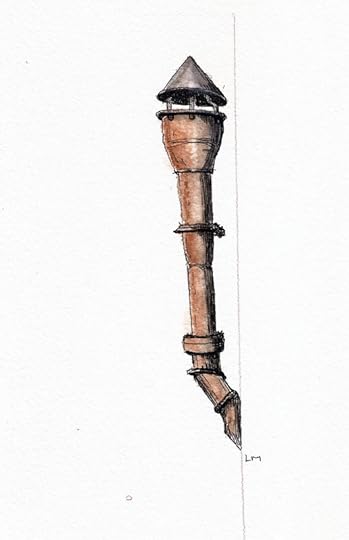
July 7, 2023
A Different Kind Of Head Painting
I find myself doing a lot of screwy things in the name of “that might be fun” and this is one of them. I wander thrift shops looking for statues, heads on pedestals, and cast animals that I add to my stuff-to-draw collection and I was in the process of doing just that when I came across a plaster cast of a head. This particular head is part of a product line produced by someone, somewhere and they pop up once in a while around here. I’ve had opportunity to draw a couple of them. They’re all about 6″ tall and meant to hang on a wall. Wish I could find more of them.
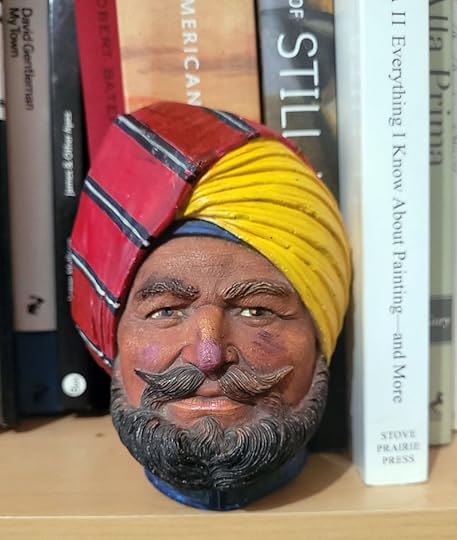
This particular example was pretty beat up with lots of scrapes, scratches and some chunks of plaster missing, most notably the tip of the guy’s nose. The price was $2 and I decided to see if I could restore it, at least to the point where I could draw it. It took far more time than it was worth to do it but it was fun and the results are acceptable to me.
I started by using a spackling compound to fill and/or build up the missing parts. I’m not sure that was a good choice but it was what I had. Then I got out a very cheap set of acrylics and went to work with a small brush. I don’t know why I have the acrylics as I’ve never used them for painting. The only tubes that had been touched were Burnt Umber and Black. My guess is that they came from Walmart (grin). But they worked ok.
One thing I learned is that a camera finds every tiny and sub-tiny white speck. I’d feel I was done and I’d take a photo only to find lots and lots of little white specks, particularly in the guy’s beard. It was hard to see them to fix them and eventually I gave up. Hope you find it satisfactory.
July 4, 2023
30×30 Failure… Or Was It?
Wow…the past month has been crazy. Mother nature has filled Quebec air with forest fire smoke, rain storms, and brisk winds. I think it’s the smoke, but my cataracts have been causing me fits. But I just had a great time because my daughter was here for two weeks and we really had fun.
This later thing cut into my #30x30DirectWatercolor experiment and I only managed 15-17 direct watercolors, all of which were total failures as art products. In the other hand, I feel I learned a lot about watercolor and about myself so I consider the experiment a big success.
I’m reluctant to talk about this simply because I have little in the way of graphics to go with the words. I was throwing my little paintings away as fast as I was making them and thought I had only one to show you. Then I cleaned off my drawing table and found a couple rejects. Both of these were discarded long before they were finished. They describe a guy using too much water and too little patience I think. A sketcher’s tempo doesn’t fit with 100% cotton paper and high humidity because the paper takes too long to dry for my patience level. I’ve come to understand why Marc Taro Holmes often does a couple paintings simultaneously.
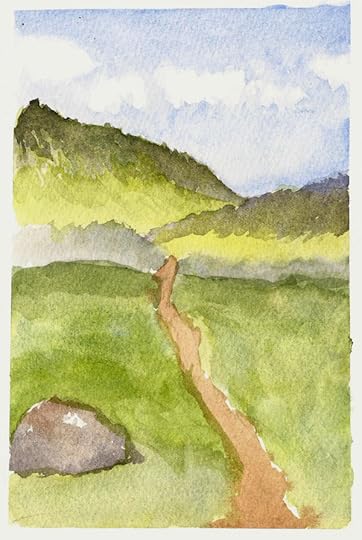
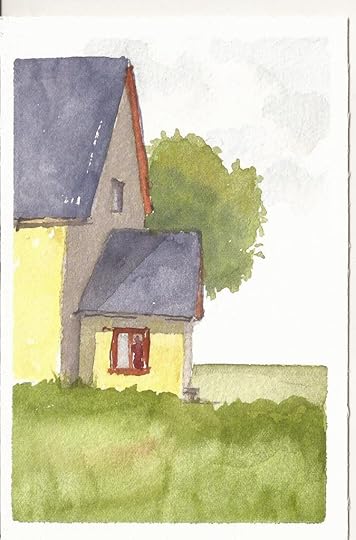
Here is a great example of my loss of perspective as I chase wet paint around the paper. This sort of thing is a breeze if I’ve got a pen in my hand but with a watercolor brush my limited brain power is consumed by the medium. I don’t know what to say about the other sketch except that I think I’d decided to do a “traditional” landscape but it too got out of hand, with everything blending to mud.
Here’s a tree I sketched on location. It’s horrible, I know, but if I’m on location, I want to draw a tree in a few minutes. Unfortunately the drying time of Fabriano Artistico is just too long for that purpose and everything melts together. I think in these situations, doing watercolor on Stillman & Birn Alpha paper would be better. I’ve heard Liz Steel suggest the same thing.
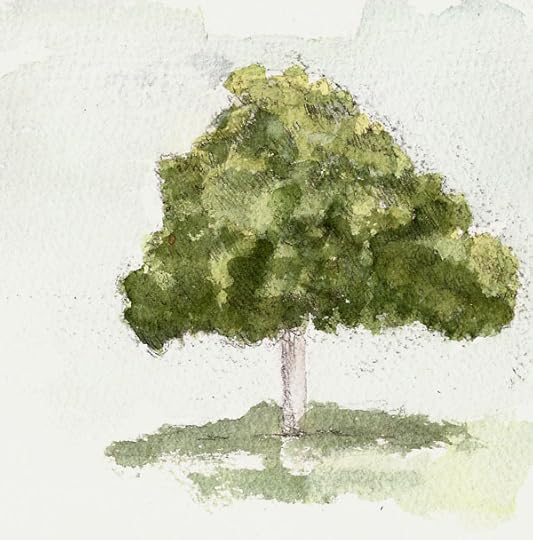
Most of my 30×30 experience (but not the examples shown here) was with what Marc calls “broken silhouette” painting where you sketch by knitting small shapes together. Marc, using his words, is interested in being “painterly” whereas I guess I’m more interested in a higher level of accuracy, or at least I think I do. So I’m not sure his broken silhouette approach suits my goals but I’m intrigued by it. Clearly one of my big problems with watercolor is that I still struggle with water/color mix and keeping it under control while also thinking about perspective, object sizes and relative locations.
One interesting thing is that I don’t seem to have this problem when I’m painting on top of lines and I think it’s because I’ve become invested in the sketch and it slows me down. Starting with watercolor causes me not to care whatever e outcome is and so rushing along down the road is what I do.
Truth is, I like to draw stuff with pointy devices. That’s where “fun” is for me in art, not in watercolor. I know that most people see the color as the fun and the drawing just a means to get there but for me, without the sketching I might as well be painting a house.
I hate “challenges” but I found this one to provide some technical training and lots of food for thought about what’s important, or not, to me. Thanks Marc, for doing this every year. Maybe by next year I’ll have it figured out (grin)
While I’m babbling I thought I’d present an exercise I do regularly. I see it as a way to improve/maintain my ability to draw accurately something I’m looking at and also to locate disparate entities in a scene relative to each other.
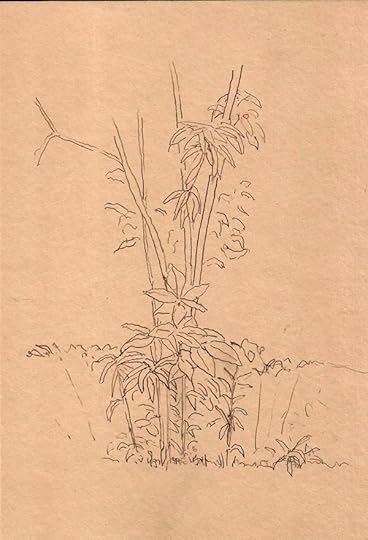
In this case I sat on a bench and looked across the path that got me there at a wall of foliage. No real “scene” existed but for my purposes that didn’t matter. I started with the lower cluster of leaves. I draw each leaf to reflect its size, shape and location, doing so as accurately as possible. After I got a bunch of those leaves drawn I chose another group of leaves (the ones higher up in the sketch and started doing the same. Emphasis was still on accuracy but also an attempt to locate that cluster relative to the first cluster. The straight tree “trunks” were my way of connecting the two clusters while looking at how well I’d done in getting everything in its place. The rest of the foliage was mostly scribbles to fill out the sketch a bit.
I do this stuff a lot because my cataracts are messing with my vision and I feel that an artist can’t work on seeing skills enough. My sketches need all the help they can get. Besides, it’s fun.
June 17, 2023
Stand Up Watercolor Sketching
Tina just wrote this comment to my last post.
I’m starting to think about using watercolors in the field again. But the whole setup part is what stalls me… I like sketching while standing, and having to attach the palette, etc. to my sketchbook or to a board crimps my style.
The old “clip the palette to your sketchbook road is full of frustration, at least it was for me. Different sketchbook sizes, left page/right page, beginning/end of book… there’s just nothing consistent about this process.
So, long ago I realized that I needed to bring my “table” along with me. Lots of people do this, using fome-core or Coroplast boards. Some clip palettes, some imbed magnets into the backing board. I’ve tried all of these methods and they work, if you’re more consistent in your sketching practice than I am. I went a different way, mounting magnets on the bottom of my palettes…all my palettes. This eliminated the need to use a metal palette. It works as well with Cotman plastic kits as metal palettes. All it takes is a little dab of 5-minute epoxy in each corner and 4 little seed magnets, like this:
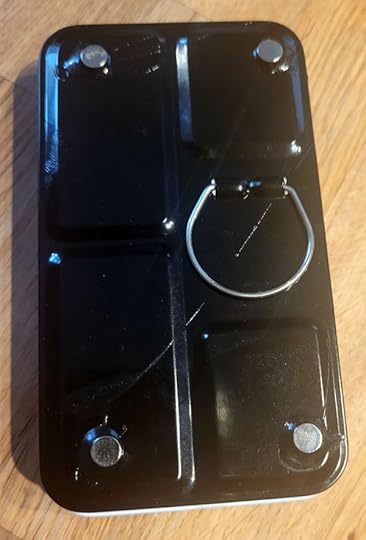
Of course this requires that your backing board be made of metal (= heavy). But what if you took some very thin plywood (mine is 3mm) and used contact cement to attach thin metal? “Come on, maybe YOU can do that Larry but I don’t have any tools.”
I found, at the dollar store, a small magnet board…a REALLY cheap magnet board. It cost me $2. It was cheap because it came with a cheap plastic frame around a thin, painted piece of metal that was backed by a piece of cardboard. Oh..and they give you some crappy magnets too.
What a deal this was because it was a game changer for me. It took about 20s to pull the frame off, toss the cardboard in the trash and I was left with a perfect sheet of metal that weighed almost nothing. Some 3M77 contact cement and my board was finished. I just dumped a bunch of art books on it to keep it flat while it dried. That was at least five years ago and she’s still going strong, albeit with scratches here and there.
Because Tina is a sketchbook user and because I know she’s like me and uses different kinds of sketchbooks, I’ll skip my single-sheet approach and just show a couple sketchbook possiblities.
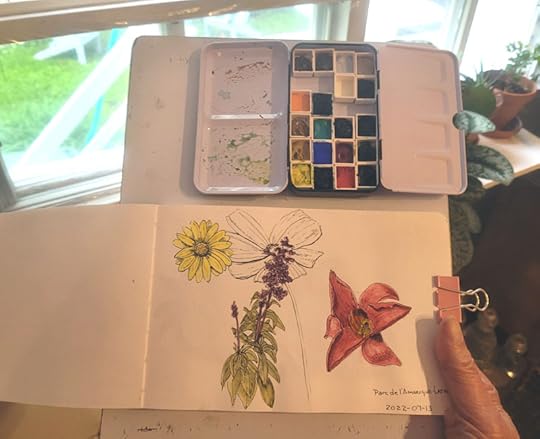 Notice first that I’m holding this in one hand. In fact, when I use this standing up, I also stuff a small water bottle in my right hand (I’m a lefty). Sometimes I put the sketchbook on top and the palette on the bottom; it makes no difference. Notice also that I’m holding it up at an angle. The palette doesn’t move.
Notice first that I’m holding this in one hand. In fact, when I use this standing up, I also stuff a small water bottle in my right hand (I’m a lefty). Sometimes I put the sketchbook on top and the palette on the bottom; it makes no difference. Notice also that I’m holding it up at an angle. The palette doesn’t move.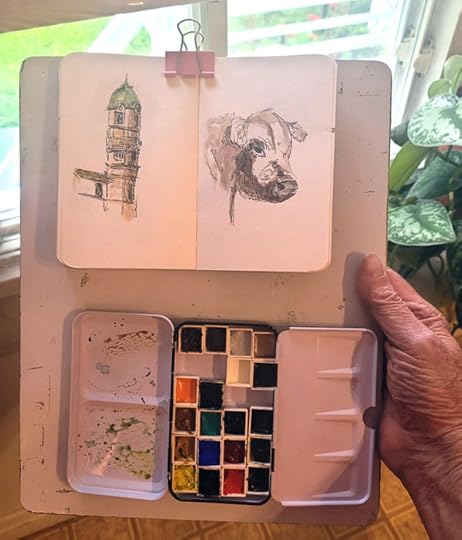 Here the palette is at the bottom and I have an A6 sketchbook on top. Works the same. A caveat here. When I’m working I typically hold the board from the top and stick the bottom of the board in my belly. In this configuration I have to be careful to keep wet pans of paint from getting on my clothes.
Here the palette is at the bottom and I have an A6 sketchbook on top. Works the same. A caveat here. When I’m working I typically hold the board from the top and stick the bottom of the board in my belly. In this configuration I have to be careful to keep wet pans of paint from getting on my clothes.
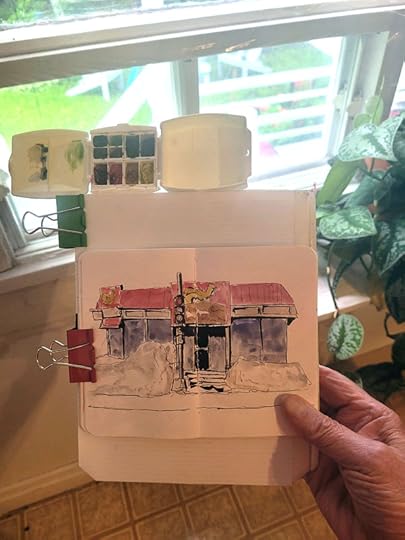 Yesterday I showed my current small bag set up. Because I use a sandwich of Coroplast to hold my paper I find I can just shove the secondary palette cup between the Coroplast sheets and clip it. It’s extremely stable and I can walk along a trail with this set up and ready to go, though I generally dump any water before I break into my marathon trot. Because Tina likes small sketchbooks I grabbed one of my scribblers as the example here. This is a never-before-seen sketch done in the middle of winter. It was probably -20C so apologies for its crude nature.
Yesterday I showed my current small bag set up. Because I use a sandwich of Coroplast to hold my paper I find I can just shove the secondary palette cup between the Coroplast sheets and clip it. It’s extremely stable and I can walk along a trail with this set up and ready to go, though I generally dump any water before I break into my marathon trot. Because Tina likes small sketchbooks I grabbed one of my scribblers as the example here. This is a never-before-seen sketch done in the middle of winter. It was probably -20C so apologies for its crude nature.I know these are lousy photos but this is less of a blog post and more of a conversation with Tina, and anyone else who found it interesting enough to read to this point.
June 16, 2023
A Ten-Minute Experiment
I was out for a walk yesterday and sat down to rest. Looking back from whence I came I “saw” a vignette and simultaneously I asked myself, “could I sketch that in 10 minutes.” The answer was yes, it’s simple so I immediately asked, “in color?”
So, I set up to do this small watercolor, and it’s not complete because the answer to my question was a no, but I stopped at 10 minutes anyway. When I got home I reassembled the kit I was using for the drawing so you can see how my Portable Painter Micro Palette works for me.
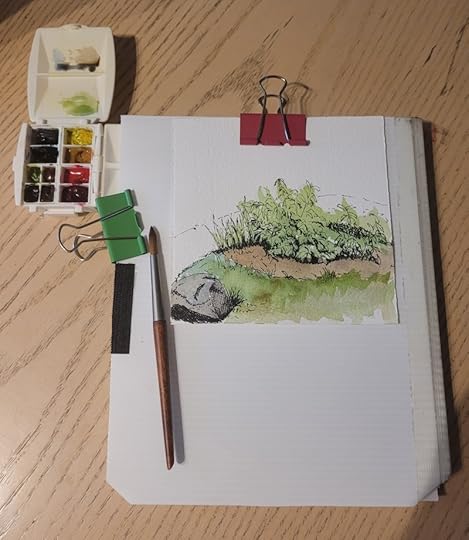
Hmmm… I just noticed that in setting this up for the photo I forgot to attach the water container to the palette. Imagine one there, please (grin).
June 14, 2023
A Bit Of Summer Sketching
We’ve had a real “meh” spring. A bunch of light rain but mostly it’s been cold, even for us. It’s raining right now but a couple days ago Chantal and I went for the first walk of the year where we didn’t have to wear a jacket, and the day was gorgeous. We walked for at least two hours and along the way we stopped to relax and take in the sun.
At one of those stops we sat at a picnic bench that faced a large tree with an apron of suckers growing from it. I thought it pretty and decided to draw it using a simple Uniball pen. I spent about 10 minutes drawing and then another five adding some color when I got home. Maybe we’ll have a summer afterall.
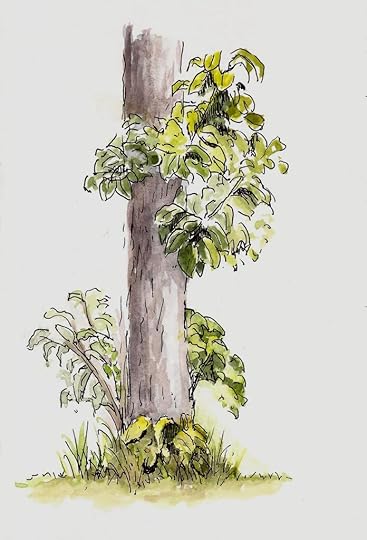
June 8, 2023
Art Without My Pen: #30x30DirectWatercolor
This is #30x30DirectWatercolor month and while I don’t participate in “events”, when Marc was visiting I told him I’d do it this year. I didn’t really know what I was signing up for when I said that. Yes, I’ve read his Direct Watercolor book (at least twice) and so I understand the concept, but I didn’t have a clue how it would make me feel to actually do it.
And how did it make me feel? Well, there are several feelings. First is naked. Without my pen I’m lost. Putting it down and picking up a brush causes me to lose my ability to put proportion and perspective on the page. Don’t know if it’s a shift in my concentration or what but things go south when I pick up a brush.
The second feeling is ineptitude. My ability to handle a brush is sorely lacking and it shows in everything I’m trying to do during 30×30. Everything goes down wonky, to use a Liz Steel word. Also, water control is tough for me, also due to a lack of experience.
And the third feeling I have is that it’s just no fun. I’ve heard lots of artists talk about doing the sketch quickly so they can get to the fun part. Well, for me, ALL the fun comes in the drawing. Painting is an afterthought, necessary evil, or something along those lines.
It’s obvious that the ineptitude feeling is a result of me placing all my emphasis on drawing and not painting. If Marc reads this he’ll giggle because fixing that problem is what #30x30DirectWatercolor is all about. I need to spend more time with a brush, following the same “put in the work” that has moved me from painting wonky cubes to being able to draw most things I see. Sigh…is this how a kid feels when he’s told to practice his times tables?
Anyway, I’ve actually done seven of these little paintings, one for each day so far. Four of them are too much of a mess to show you. Marc said in a recent post that 2 out of 10 is pretty good. I suppose he’s right. Here are three of my seven. I hope I get better.
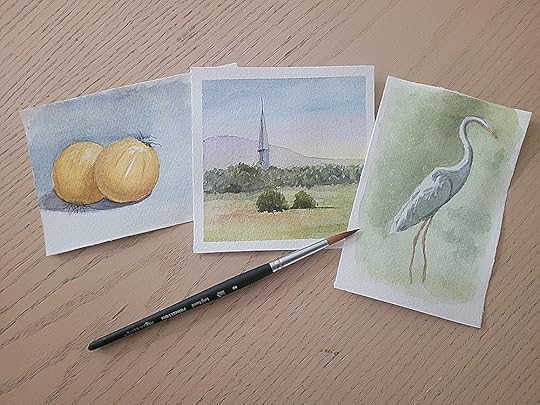 In case you can’t recognize them, Left: onions, Center: Iles aux Grues landscape, and Right: Heron
In case you can’t recognize them, Left: onions, Center: Iles aux Grues landscape, and Right: Heron
May 27, 2023
The Advantages Of Single Sheet Sketching
My last post generated some really great feedback. Those comments covered many of the reasons to use a sketchbook and some of why some like single sheets. I started to respond to each of those comments but concluded that everything I would say should be in the post I promised to make and so consider this to include answers to those comments.
Just to be clear…again, I’m not advocating people to give up sketchbooks. I still use them. Here I’m simply presenting my own reasons for moving more and more to single sheet sketching and maybe, just maybe present that approach in a way that doesn’t cause a sketcher to lose the reasons they use sketchbooks. Heck, this IS the struggle, isn’t it? I’ve always used sketchbooks to keep my sketches chronologically organized. While I talk about throwing them on shelves and never look at them, sketchbooks are still neater than having a bunch of sheets in a pile. Ok…here we go.
I see three major advantages to using single sheets and the importance of each has a lot to do with how/why and with what you sketch. Therefore, I will expose my biases as I proceed.
Freedom of paper choice: I sketch with pencil (shaded drawings), pen only, pen and wash, and with paint (gouache, watercolor). Each of these is best done with a different type of paper. Doing a shaded pencil drawing requires very different paper from when I do a watercolor and so. It seems that with sketchbooks I’m always compromising in this regard. Second, I’m fickle when choosing a particular paper size and color. A landscape A5 just won’t do when I want to do a portrait. Sometimes I like tan paper, or gray paper. For each of these choices I need a different sketchbook. The result is that I always have several sketchbooks “in progress” and still I’m compromising what paper I use for a particular sketch.
Organization: Consider the above. I’ve got several sketchbooks, of different sizes and shapes on the go simultaneously. In that context, the notion that my sketchbooks are maintaining a chronology of events just falls apart. And, of course, there’s always the times when you work on a single sheet to do a special project. There’s no way to truly organize chronologically. Of course, if I could just choose a sketchbook/paper/approach, this would be easy and many do.
Presentation: Because I create sketches and not sketchbooks, I don’t worry about “working across the spread” or designing pages to include notes, quotes and other stuff. If I write notes they are just about the sketch and I put them on the back of each sketch (would make a mess for those creating sketchbooks. But presentation IS important. To me, the most value I get from my sketchbooks is when I’m carrying them and someone asks about my art and I can hand them a sketchbook to look through. This is a problem to solve for a single-sheet sketcher, but it can work with a bit of thought.
Ease of use: I’ve added this fourth advantage cuz I find it true. Some sketchbooks are simply hard to hold and draw while standing. A portrait A5 isn’t so bad but an A5 landscape, particularly if you’re at the beginning or end of it, presents a struggle. Some people never stand while they sketch. I do. People who do carry a support for their sketchbook and this works dandy, but sketchbooks clipped to a board are always less user friendly than are single sheets clipped to that same support.
Methods to solve some of these problems are many and varied. Here are mine.
Paper flexibility and Ease of Use: When using single sheets you have complete flexibility with respect to paper. I carry several sizes, colors and types of paper when I go out on a sketching section. The only limit is that the paper has to fit within the boundaries of my support. The weight of the support is far less than any sketchbook. I first saw the use of Coroplast as a support when sketching with Marc Taro Holmes (I admit that I don’t get out much). He’ll tape sheets of watercolor paper to 4-5 pieces of Coroplast and this means there’s no set up on site, a convenient way to carry his sketches, and he can even work on multiple paintings at once as he can lean one painting against a tree while working on another one. This also makes it very easy for him to display multiple results during the USK throw-downs that occur at the end of events.
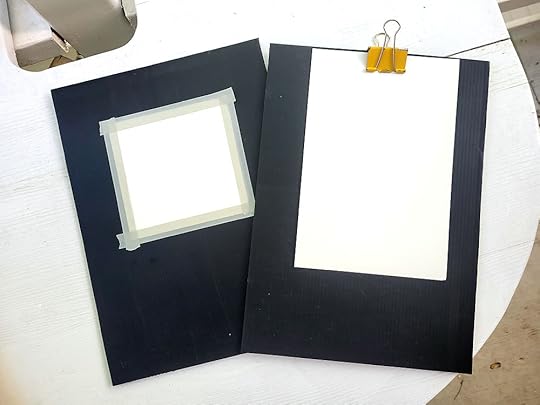
This shows a couple methods for attaching paper. Mostly I use clips but it’s sometimes nice to have the border frame resulting from taping off the paper. For me, the size of the Coroplast is important. The width is the widest thing I can put in my bag and the length needs to be long enough that I can push the bottom of it into my belly while holding it from the top with one hand.
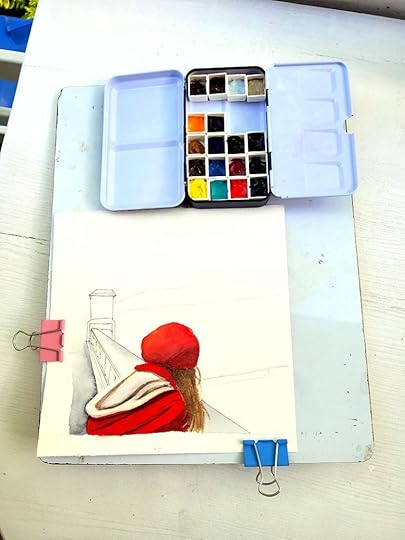
This is the board I use most often. It’s a very thin piece (1/8″) of plywood with a sheet of very thin metal glued to it. I use spray contact cement for this and the metal came from a small magnet board I bought from the dollar store. They come with a plastic frame that’s easy to remove. I like this because, by gluing tiny magnets to my paint palette, I can magically fix it to the board.
Carrying paper only requires a couple sheets of cardboard or Coroplast with a rubber band to sandwich your paper selection between them. I use a fabric tape hinge to create a “book” that holds my paper.
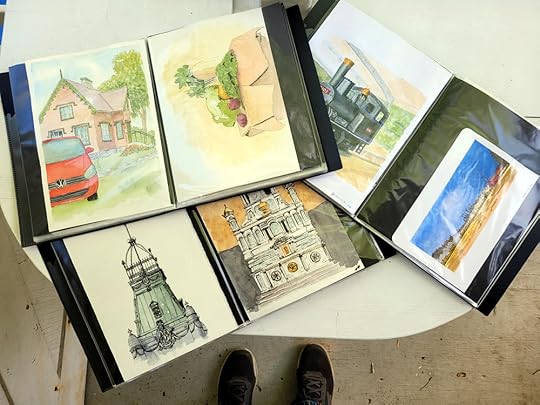
Organization and Presentation: Again, there are many solutions but I really love using 9×12 portfolios you can find at any art store. And the best part is that this is far superior to sketchbook organization for the simple reason that you can stick sketches in these in chronological order regardless of what paper they were done on. Thus, all the sketches I’ve done while having several sketchbooks on the go suddenly appear in complete chronological order in a portfolio. And the ability to display sketches is, in my opinion, far superior. I’ve taken these portfolios to show-n-tell events and people loved looking at them because it was so easy to turn the pages. I love the fact that each sketch is covered in plastic so all those pesky hands aren’t touching them.
For me, carrying around an entire portfolio so I can show them to someone on the street sort of defeats the idea of keeping things light. So, what I do is simply place recently done sketches in my paper pouch. Then, when someone is curious, I pull it out just as I would a sketchbook. This works well and eventually sketches get moved to a portfolio.
Oh…one last thing. Kate B. talked about leaving sketches/sketchbooks for people to find. A great idea in my opinion. Recently, somewhere, I left a couple sketchbooks for someone to find and an entire sketch kit in case they became inspired (grin).
May 24, 2023
Are Sketchbooks Important?
I Made some comments while discussing the loss of my sketch bag and replacement of it. While these were casual comments that weren’t integral to the blog posts, they stirred some responses. I think it’s fair to say that my comments can be put into two piles and summarized thusly:
1) I don’t value my sketchbooks and, in fact, find them something of a nuisance as they accumulate.
2) More and more I’m abandoning sketchbooks in favor of single sheets.
I received several emails about these comments. Some defended the use of sketchbooks and one (there’s always one) wanted to convince me that I shouldn’t “put myself down” by saying my sketchbooks don’t matter. And then Susan King wrote this in the public comments:
“I thought I was the only one who didn’t look at my old sketchbooks. I recently filled two banker’s boxes and put them in the basement because I ran out of shelf space. (I did keep out the ones that have course material in them as I sometimes do go back and look at those.) I was tempted to throw away rather than store the old ones. I’d love to hear your thoughts on this whole subject sometime!”
It was like looking in a mirror. These comments made me think that maybe there was something to say here.
Those of us who joined the urban sketching movement have been taught that one does urban sketching in a sketchbook, and we hear it over and over and over and over again. If you look around, however, you see any number of people at USK events working on single sheets. I’ll talk about that later but today I want to respond to Susan’s curiosity.
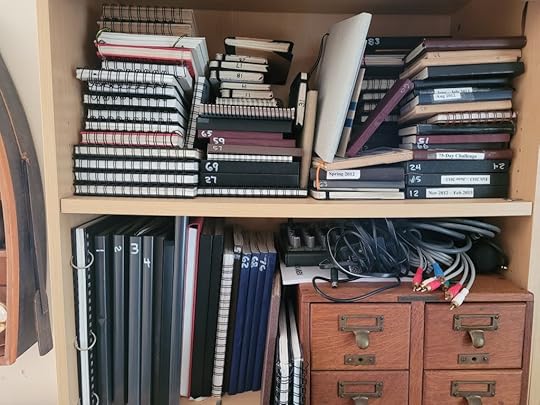
When I started sketching I couldn’t draw anything and my attempts were all done on photocopy paper. I remember drawing, or trying to draw, cubes…lots of cubes. Eventually though, after proper indoctrination into USK, I bought a sketchbook, a little A6 book that was small enough to hide as I would go out to draw. And I started filling sketchbooks…lots of sketchbooks. Above is a photo of the only pile still in my office. Like Susan, I’ve got a couple boxes of the darn things in the basement, filled when I needed shelf space. The portfolios in the lower left of that photo are the only things that have moved on those shelves in a decade. They are how I store my single sheet sketches.
Sketchbooks are great if you want to create sketchbooks, those “let me show you the fine art I’ve produced” books that many enjoy. Those wanting to discuss and implement “page layouts” like sketchbooks. Some use sketchbooks as a way of keeping score (look at my shelf of sketchbooks) and all of these reasons are good reasons for sketching in sketchbooks.
But I’ve never been either of those kind of sketchbookers. For me a sketchbook has always been a tool, a place to sketch. I’ve never been shy about saying “I don’t know if I’m an artist. I just draw stuff.” And when I’m done drawing something, I turn the page and don’t look back. I don’t create sketchbooks, I create sketches.
It’s not everyone’s style but even USK tells us that this is “all about the process, not the product.” It certainly is for me. Am I proud that I can now draw something? You bet. A guy who hits a home run is proud too, but he doesn’t spend his nights watching a video of it. He’s too busy trying to hit another one.
So, no big deal here, but Susan and I, and probably some other folks look at a decade’s worth of sketchbooks as something in the way, not something precious. But I’ll finish this by pointing out that both Susan and I haven’t thrown our sketchbooks away. I wish I could say why that is since I never look at them but there you have it. I must see some value in keeping sketches. Sketchbooks aren’t the only way, however.
Just so nobody gets the wrong idea (someone surely will), I’m not dumping on the use of sketchbooks by anyone or for any reason. For me, however, they are getting less and less use. I’ll talk about that next time.



